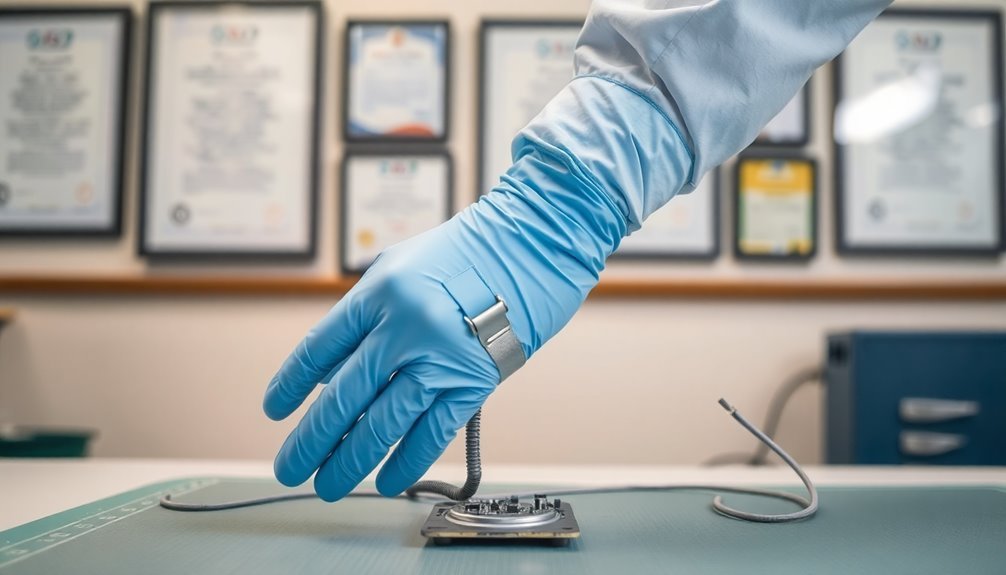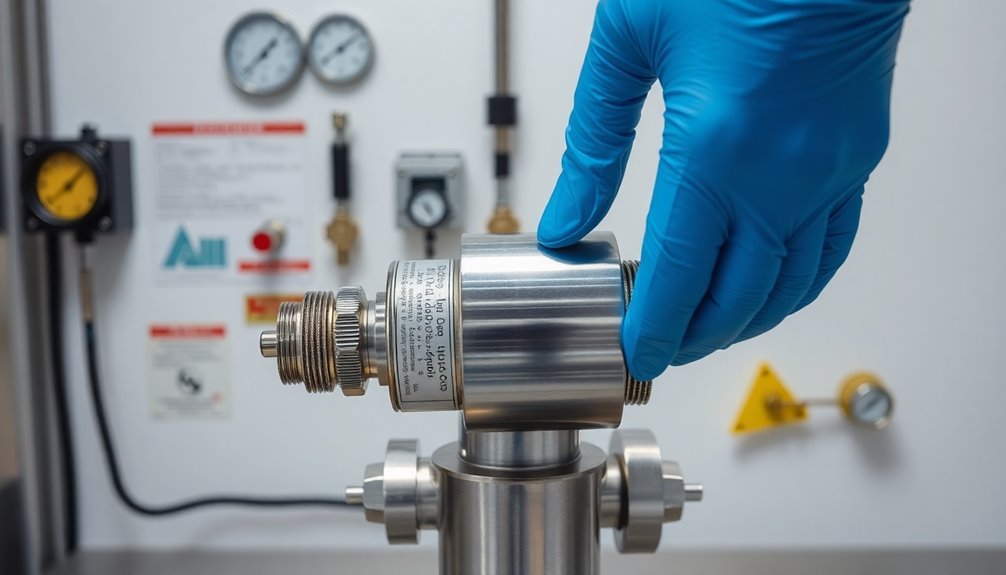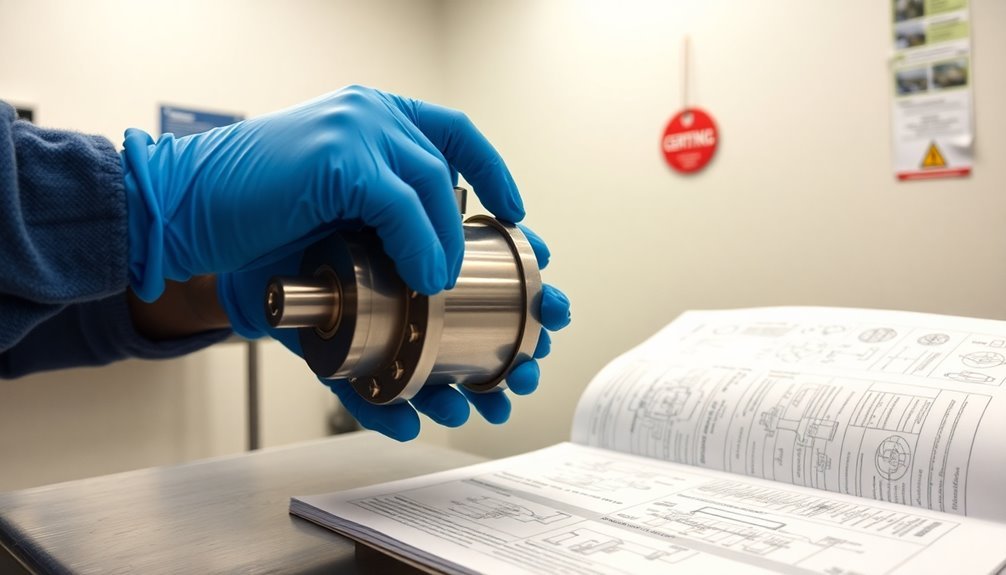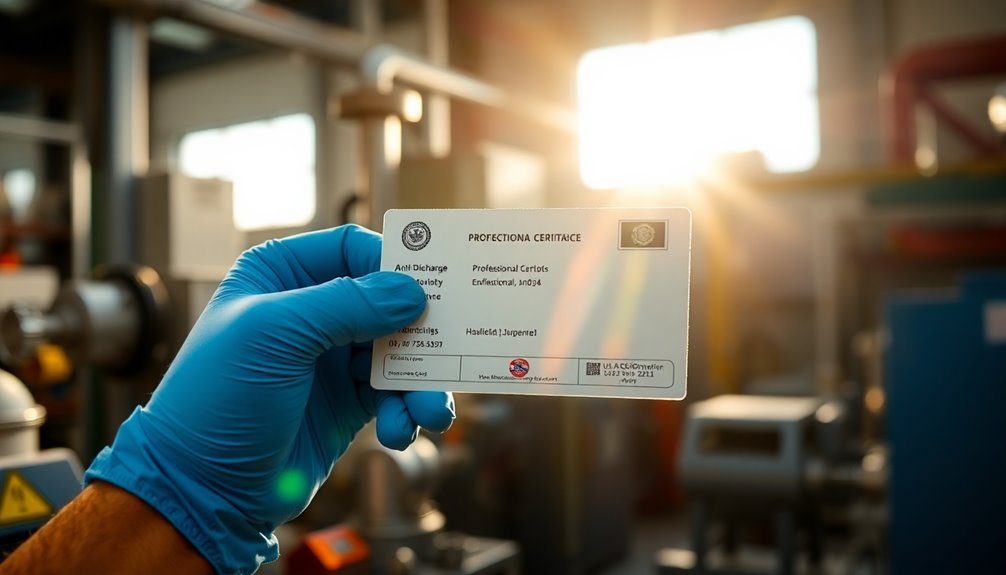To handle anti-discharge devices safely, you'll need either an ESDA Program Manager Certification or an iNARTE ESD Engineer/Technician Certification. These certifications verify your understanding of static electricity fundamentals, ESD control procedures, and proper handling techniques. You'll learn essential skills like using ESD protective workstations, implementing safety protocols, and maintaining compliance with ANSI/ESD S20.20 standards. Regular requalification and ongoing training guarantee you stay current with industry requirements. The certification process also covers equipment maintenance, documentation procedures, and workplace assessment protocols – critical knowledge for anyone working with ESD-sensitive components.
ESD Certification Types

Designed to meet rigorous industry standards, ESD certification programs come in two primary types: Program Management and Device Design. Each type serves distinct purposes and caters to different professional roles within the ESD protection field.
The rising device circuitry density in modern electronics has made proper ESD certification more critical than ever before.
If you're involved in implementing and managing ESD control programs in your facility, you'll want to pursue the ESDA Program Manager Certification. This ten-course program focuses on meeting ANSI/ESD S20.20 requirements and covers essential topics like training, audit requirements, and facility grounding.
You'll learn to develop and assess ESD programs while guaranteeing compliance with international standards.
For those working specifically with ESD device protection design, the ESDA Device Design Certification is your best choice. This twelve-course program equips you with knowledge of protection techniques, design principles, and testing methodologies.
You'll gain expertise in practical applications and troubleshooting.
While both certifications guarantee compliance with industry standards, they differ in their focus. Program Management emphasizes facility requirements and practical application, while Device Design concentrates on technical aspects of protection systems.
Your choice should align with your career goals and professional responsibilities.
Core Training Requirements
After obtaining your ESD certification, you'll need to understand the thorough training requirements that form the backbone of any effective ESD control program. You'll need to master extensive training modules that cover static electricity fundamentals, electrostatic discharge physics, and your organization's specific ESD control procedures. Training must include subcontractors and suppliers who handle ESD-sensitive items.
You'll participate in tailored training sessions designed for your specific job role, whether you're a line employee or part of management. The training must align with your company's written ESD control plan and clearly define your responsibilities within the program.
You'll learn about ESD control materials, equipment usage, and proper handling techniques through various resources, including computer-based training, technical papers, and product data sheets.
To maintain your certification, you'll need to demonstrate ongoing compliance through regular auditing and verification processes. You'll work with specialized test equipment like electrostatic field meters and undergo periodic requalification to guarantee your knowledge stays current.
Throughout your training, you'll have access to knowledgeable personnel who can answer questions and provide guidance on ESD control practices. Remember, the training content must remain consistent across all facilities and locations within your organization.
Handling Equipment Standards

The proper handling of ESD-sensitive equipment demands strict adherence to established industry standards, including ESD TR20.20 and DODM 4100.39.
You'll need to conduct all handling and packaging operations at an ESD protective workstation, or when that's not available, you must use an ESD field service kit.
You're required to use specific equipment that meets anti-discharge standards. This includes ESD-safe tools, static-controlled bags for storage and shipping, and proper grounding straps to maintain static control. Static electricity can generate charges up to 35,000 volts from everyday activities.
You'll need to guarantee all conductive materials used for transport meet specifications, and you must properly ground all ESD protective equipment before use.
Your equipment must undergo regular inspections to maintain compliance. You'll need to document all handling procedures and maintain proper ESD markings on sensitive items.
When you're working with ESDS items, you must implement thorough static control measures throughout the handling process. The equipment you use needs to align with both ESD TR20.20 specifications and DODM 4100.39 guidelines.
Remember that your protective equipment and workstations are subject to periodic audits to verify compliance with these standards.
Safety Protocol Certification Levels
Safety protocol certifications typically fall into distinct levels, ranging from entry-level to advanced professional designations. For your work with anti-discharge devices, you'll want to start with entry-level certifications like the Associate Safety Professional (ASP) or Graduate Safety Practitioner (GSP). These provide essential foundational knowledge in safety management systems and risk assessments.
As you gain experience, you'll need to progress to intermediate certifications. The Certified Safety Professional (CSP) is regarded as the gold standard and requires a bachelor's degree plus prior qualifying credentials. CSP holders typically earn a median base salary of $104,000 annually.
Alternatively, you might pursue the Safety Management Specialist (SMS) certification, which validates your expertise in safety management within organizations.
You'll also need to evaluate specialized certifications based on your specific role. If you're working with hazardous materials or environmental risks, the Certified Industrial Hygienist (CIH) certification demonstrates advanced knowledge in identifying and controlling health hazards.
For international work, the NEBOSH National or International Diploma offers globally recognized credentials. Each certification level builds upon the previous one, ensuring you're fully qualified to handle anti-discharge devices safely and effectively.
Certification Testing Process

Building on your safety protocol certifications, you'll encounter a rigorous testing process that examines your competency across four main areas. You'll need to demonstrate mastery in system design verification, operational testing procedures, enclosure integrity assessment, and discharge testing protocols. Proper documentation requires maintaining detailed inspection tags and records similar to fire extinguisher maintenance logs.
During design verification, you'll inspect installations against approved drawings and verify detector placements. Your operational testing skills must include proper detector activation methods and supervision of electrical systems, including backup power verification.
| Testing Area | Critical Skills | Impact |
|---|---|---|
| Design Check | Drawing Analysis | Life Safety |
| Operations | Detector Testing | System Reliability |
| Integrity | Fan Testing | Protection Assurance |
For enclosure integrity testing, you'll work with door fan assemblies following NFPA guidelines, ensuring the space meets containment requirements without temporary solutions. Your discharge testing certification requires expertise in concentration recording, proper sample tubing selection, and ventilation management.
You'll need to show proficiency in checking room dimensions, verifying nozzle specifications, and confirming interlocking equipment functionality. The certification process emphasizes your ability to maintain system integrity while ensuring all components work together seamlessly.
Equipment Compliance Guidelines
To meet safety standards for anti-discharge equipment, you'll need to comply with ANSI/ESD S20.20 requirements and maintain proper grounding systems that follow ANSI/ESD S6.1 protocols.
Your device installation must include appropriate ESD control measures, including defined Electrostatic Protected Areas (EPAs) and proper use of dissipative or conductive materials for all handling equipment.
You're required to maintain detailed documentation of all equipment checks, maintenance procedures, and compliance testing, with specific attention to resistance-to-ground measurements and ionization performance verification. The qualification tests should be conducted under low-humidity conditions of 12% ± 3% relative humidity at 23°C ± 3°C.
Safety Standards For Equipment
Properly qualified anti-discharge equipment must meet rigorous compliance guidelines through a systematic three-phase verification process. You'll need to verify that your equipment passes Installation Qualification (IQ), Operational Qualification (OQ), and Performance Qualification (PQ) standards before deployment.
| Phase | Key Requirements |
|---|---|
| IQ | Correct installation, parts verification, utility connections |
| OQ | Real condition testing, operational scenarios, system consistency |
| PQ | Production-like testing, long-term performance verification |
| Maintenance | Regular inspections, calibrations, system checks |
| Requalification | Post-modification testing, upgrade validation |
Your equipment must undergo thorough installation verification to confirm proper setup and functionality according to manufacturer specifications. All handling equipment should comply with ANSI B11.0 standards for machinery safety during material processing and testing. Once installed, you'll need to test it under actual operating conditions, running through various scenarios to verify consistent performance within specified parameters. The final qualification phase requires you to demonstrate that your equipment can maintain reliable performance under production conditions.
Don't forget that qualification isn't a one-time process. You'll need to implement ongoing maintenance protocols and conduct periodic requalification, especially after modifications or upgrades. This verifies that your equipment maintains compliance with GMP standards and continues to deliver consistent, high-quality results throughout its operational lifecycle.
Proper Device Installation Requirements
When installing anti-discharge devices, you'll need to meet strict technical and regulatory requirements across multiple compliance standards.
Your installation must comply with Department of Defense Handbook specifications and safety standards, including EMC/EMI compliance and ESD immunity requirements.
You'll need to guarantee your device meets UL and CSA certifications, along with RoHS compliance for European and California markets. Testing must be conducted in accredited laboratories for all certifications.
For wet-hose installations, you must incorporate specific antidrain mechanisms that prevent hose drainage between deliveries. The system should maintain proper pressure levels and include automatic discharge devices that reduce voltages to 30 volts or less within two seconds.
- Install non-bypassable interlocks for systems operating above 500 volts
- Implement guards and barriers to protect against accidental contact with high-voltage components
- Include proper test points for voltage measurement during maintenance
- Guarantee automatic or semiautomatic predetermined-stop type shutoff valves
- Set up antidrain valves that respond only to appropriate pump pressure levels
You'll need to document all installations and maintain certification records from accredited laboratories, particularly for ESD immunity and conducted emissions testing. Remember that CE marking is mandatory for European market access.
Maintenance Record Documentation Rules
Maintaining thorough equipment records forms the cornerstone of anti-discharge device compliance. You'll need to document detailed maintenance activities, including dates, times, and the names of personnel performing the work.
For each device, you must record specific identification details like make, model, and serial numbers.
Your records should include exhaustive information about parts replacements, calibration data, and test results using standardized units of measurement. You're required to document any potential risks identified during maintenance and the steps taken to address them.
When recording maintenance activities, you'll need to use approved templates that guarantee consistency and meet regulatory standards set by organizations like the FDA and Joint Commission.
You must maintain proof of personnel qualifications and regularly update equipment status reports to reflect current conditions. It's crucial to implement proper timestamping practices and retain all documentation for the period specified by regulatory bodies.
You'll need to conduct periodic audits of your maintenance logs to verify accuracy and compliance. Remember to incorporate feedback from device users and keep your records readily accessible for regulatory inspections and compliance verification.
Workplace Assessment Requirements

You'll need to conduct thorough workplace assessments by following site safety evaluation protocols that examine all handling areas, protective equipment, and containment zones.
When performing equipment hazard risk analysis, you must check all anti-discharge devices for proper grounding, functionality of protective measures, and potential failure points.
Storage area inspection standards require you to verify proper ESD-protective packaging, maintain appropriate humidity levels, and regularly test the effectiveness of static-control measures in all storage locations.
Site Safety Evaluation Protocol
A thorough site safety evaluation protocol forms the foundation of any successful anti-discharge device handling program. You'll need to conduct thorough assessments that identify potential hazards and vulnerabilities in your workplace.
Your evaluation should involve both management and workers to guarantee all perspectives are considered, leading to more effective safety measures.
When performing your site assessment, you'll want to follow a systematic approach that includes detailed documentation and clear assignment of responsibilities. It's crucial to develop specific checklists tailored to anti-discharge device handling areas and establish corrective action plans for any identified issues.
- Conduct a complete facility walkthrough focusing on areas where anti-discharge devices are handled or stored
- Document all findings with photographs and detailed descriptions of potential safety concerns
- Create detailed checklists covering PPE requirements, emergency response procedures, and handling protocols
- Assign clear roles and responsibilities to team members involved in the assessment process
- Develop and implement corrective actions based on assessment findings, prioritizing critical safety issues
Equipment Hazard Risk Analysis
Conducting equipment hazard risk analysis requires a thorough understanding of workplace assessment requirements. You'll need to systematically evaluate each anti-discharge device handling area while documenting potential risks and their severity levels. This assessment forms a vital part of your certification requirements.
| Risk Factor | Required Action |
|---|---|
| Chemical Exposure | Implement containment protocols and specify PPE requirements |
| Mechanical Hazards | Document equipment safety features and maintenance schedules |
| Ergonomic Risks | Assess handling procedures and establish proper lifting techniques |
| Emergency Scenarios | Develop response protocols and evacuation procedures |
| Equipment Failure | Create maintenance checklists and backup systems |
You must prioritize hazards based on their potential impact and likelihood of occurrence. Your analysis should include specific control measures for each identified risk, following the hierarchy of controls from elimination to PPE use. Don't forget to involve your team members in the assessment process – they often provide valuable insights into daily operational risks.
Remember to maintain detailed documentation of your findings and regularly update your risk assessments when equipment or procedures change. You'll need these records for certification compliance and ongoing safety management.
Storage Area Inspection Standards
Building on a thorough hazard risk analysis, proper storage area inspection standards represent a fundamental component of workplace safety certification. When you're handling anti-discharge devices, you'll need to guarantee your storage areas meet strict safety protocols and inspection requirements.
You must regularly assess these areas to maintain compliance and prevent workplace accidents.
To effectively inspect storage areas, you'll need to focus on key safety elements that protect both personnel and equipment. Your inspection process should incorporate standardized checks for material storage conditions, walkway clearance, and structural integrity of storage systems.
You'll also need to verify that all flammable materials are properly contained and stored according to regulations.
- Check all materials for proper stacking and storage arrangements, guaranteeing stability
- Verify that all passageways remain clear and unobstructed for safe movement
- Inspect storage racks thoroughly for any signs of damage or instability
- Guarantee heavy items are stored at lower levels to minimize falling hazards
- Confirm proper handling and storage procedures for any flammable liquids in the area
Regular documentation of these inspections helps maintain certification compliance and provides evidence of your commitment to workplace safety standards.
Certification Renewal Procedures
The renewal procedures for anti-discharge device handler certification follow a structured timeline, similar to NPDES permit renewals. You'll need to submit your renewal application at least 180 days before your certification expires to maintain continuous coverage and avoid enforcement actions.
To renew your certification, you can submit your application online, by mail, or in person. You'll need to provide your renewal notice or a copy of your current certification along with the required fees. Standard renewal fees apply, though you might qualify for a fee waiver if you're a government employee using the certification for work duties.
If you submit your renewal application on time, your current certification will remain valid until the regulatory agency makes a final decision on your renewal. However, if you're late with your application, you'll face penalties and risk losing your certification coverage.
Don't forget that you can't modify your certification during the continuation period – modifications are only possible upon re-issuance. If you've stopped handling anti-discharge devices, you should notify the regulatory agency to inactivate your certification rather than pursuing renewal.
Frequently Asked Questions
Can I Transfer My Certification Between Different States or Countries?
You can often transfer your certification between states and countries if it's based on recognized standards like DODM 4100.39 or IEC 61340, though you'll need formal evaluation and approval from local authorities.
What Happens if I Fail the Certification Exam Multiple Times?
If you fail multiple times, you'll face increased training requirements, higher costs, and potential career delays. You may need customized retraining, and your employer might review your performance or require additional preparation.
Are There Any Physical Requirements or Medical Examinations Needed?
You don't need any specific physical exams or medical requirements to handle anti-discharge devices. Instead, you'll need proper training on ESD control procedures and must follow safety protocols in static-controlled environments.
How Long Does the Entire Certification Process Typically Take?
While the exact duration isn't specified, you'll need to study Fire Code chapters and NFPA 30, take a written exam, and achieve a 70% passing score. Plan for several weeks of preparation.
Can I Work Under Supervision While Waiting for My Certification?
Yes, you can work under qualified supervision while pursuing certification. You'll need to strictly follow safety protocols and your supervisor's guidance during this period to guarantee proper training and compliance.
In Summary
You'll need to maintain valid ESD certifications through regular renewal and testing. Keep your core handler certification current, stay updated on safety protocols, and verify you're meeting workplace assessment requirements. Don't forget to document your equipment compliance and complete all necessary training modules. Regular recertification shows your commitment to proper anti-discharge device handling and workplace safety standards.





Leave a Reply